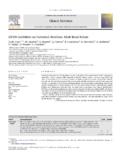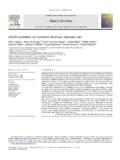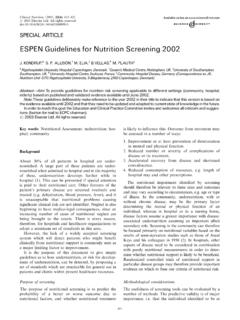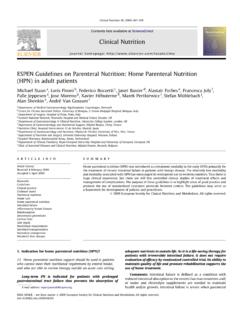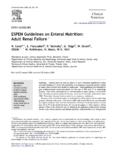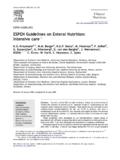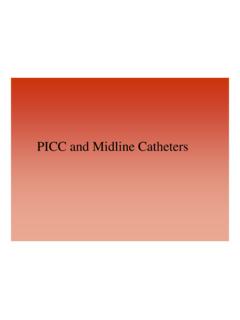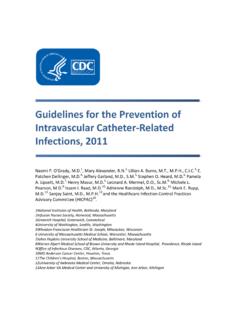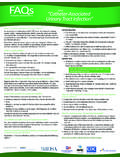Transcription of Central Venous Catheters - ESPEN
1 ESPEN Guidelines on Parenteral Nutrition: Central Venous Catheters (access, care, diagnosis and therapy of complications)Mauro Pittirutia, Helen Hamiltonb, Roberto Biffic, John MacFied, Marek PertkiewiczeaCatholic University Hospital, Roma, ItalybJohn Radcliffe Infirmary, Oxford, United KingdomcDivision of Abdomino-Pelvic Surgery, European Institute of Oncology, Milano, ItalydScarborough Hospital, Scarborough, United KingdomeMedical University of Warsaw, Polandarticle infoArticle history:Received 4 February 2009 Accepted 31 March 2009 Keywords.
2 GuidelinesEvidence-basedClinical practiceParenteral nutritionCentral Venous accessVenous access devicesMidline cathetersPICCC entral Venous cathetersTotally implantable portsTunneled cathetersPeripheral parenteral nutritionHome parenteral nutritionUltrasound guidanceCatheter-related bloodstream infectionNeedle-free connectorsChlorhexidineAntibiotic lock therapyExchange over guide wireHeparin lockSutureless securing devicesCatheter-related Venous thrombosisPinch-off syndromeFibrin sleevesummaryWhen planning parenteral nutrition (PN), the proper choice, insertion , and nursing of the Venous accessare of paramount importance.
3 In hospitalized patients, PN can be delivered through short-term, non-tunneled Central Venous Catheters , through peripherally inserted Central Catheters (PICC), or for limitedperiod of time and with limitation in the osmolarity and composition of the solution throughperipheral Venous access devices (short cannulas and midline Catheters ). Home PN usually requires PICCsor if planned for an extended or unlimited time long-term Venous access devices (tunneled cathetersand totally implantable ports).The most appropriate site for Central Venous access will take into account many factors, including thepatient s conditions and the relative risk of infective and non-infective complications associated witheach site.
4 Ultrasound-guided venepuncture is strongly recommended for access to all Central veins. Forparenteral nutrition, the ideal position of the catheter tip is between the lower third of the superior cavavein and the upper third of the right atrium; this should preferably be checked during the bloodstream infection is an important and still too common complication of parenteralnutrition. The risk of infection can be reduced by adopting cost-effective, evidence-based interventionssuch as proper education and specific training of the staff, an adequate hand washing policy, properchoices of the type of device and the site of insertion , use of maximal barrier protection during insertion ,use of chlorhexidine as antiseptic prior to insertion and for disinfecting the exit site thereafter, appro-priate policies for the dressing of the exit site, routine changes of administration sets.
5 And removal ofcentral lines as soon as they are no longer non-infective complications of Central Venous access devices can also be prevented by appropriate,standardized protocols for line insertion and maintenance. These too depend on appropriate choice ofdevice, skilled implantation and correct positioning of the catheter , adequate stabilization of the device(preferably avoiding stitches), and the use of infusion pumps, as well as adequate policies for flushingand locking lines which are not in use. 2009 European Society for Clinical Nutrition and Metabolism.
6 All rights recommendations about the indications for and theuse of the different types of Venous access devices availablefor parenteral nutrition1. What is the role of peripheral parenteral nutrition? Central Venous access ( , Venous access which allows deliveryof nutrients directly into the superior vena cava or the rightatrium) is needed in most patients who are candidates forparenteral nutrition (PN).In some situations however PN may be safely delivered byperipheral access (short cannula or midline catheter ), as whenusing a solution with low osmolarity, with a substantialproportion of the non-protein calories given as is recommended (Grade C) that peripheral PN (given througha short peripheral cannula or through a midline catheter )
7 Shouldbe used only for a limited period of time, and only when usingnutrient solutions whose osmolarity does not exceed 850 lists available atScienceDirectClinical Nutritionjournal homepage: $ see front matter 2009 European Society for Clinical Nutrition and Metabolism. All rights Nutrition 28 (2009) 365 377 Summary of statements: Central Venous CathetersSubjectRecommendationsGrade NumberChoice of route for intravenousnutritionCentral Venous access ( , Venous access which allows delivery of nutrients directly into the superior venacava or the right atrium) is needed in most patients who are candidates for parenteral nutrition (PN).
8 C1In some situations however PN may be safely delivered by peripheral access (short cannula or midlinecatheter), as when using a solution with low osmolarity, with a substantial proportion of the non-proteincalories given as is recommended that peripheral PN (given through a short peripheral cannula or through a midline catheter )should be used only for a limited period of time, and only when using nutrient solutions whose osmolaritydoes not exceed 850 PN should not normally be given via short cannulas as these carry a high risk of dislocation PN, whether through short cannulas or midline Catheters , demands careful surveillance of PN catheter deviceShort-term: many non-tunneled Central Venous Catheters (CVCs), as well as peripherally inserted centralcatheters (PICCs), and peripheral Catheters are suitable for in-patient.
9 PICCs, Hohn Catheters , and tunneled Catheters and ports are appropriate. Non-tunneled centralvenous Catheters are discouraged in HPN, because of high rates of infection, obstruction, dislocation, andvenous use and HPN (>3 months) usually require a long-term device. There is a choice between tunneledcatheters and totally implantable devices. In those requiring frequent (daily) access a tunneled device isgenerally of vein for PNThe choice of vein is affected by several factors including venepuncture technique, the risk of relatedmechanical complications, the feasibility of appropriate nursing of the catheter site, and the risk of thromboticand infective use of the femoral vein for PN is relatively contraindicated, since this is associated with a high risk ofcontamination at the exit site in the groin.
10 And a high risk of Venous approaches to the internal jugular vein (either anterior or posterior to the sternoclavicular muscle) arenot recommended, since the exit site is difficult to nurse, and there is thus a high risk of cathetercontamination and catheter -related of CVCsThere is compelling evidence that ultrasound-guided venepuncture (by real-time ultrasonography) isassociated with a lower incidence of complications and a higher rate of success than blind support is therefore strongly recommended for all CVC insertions. Placement by surgical cutdownis not recommended, in terms of cost-effectiveness and risk of placement of PICCs, percutaneous cannulation of the basilic vein or the brachial vein in the midarm, utilizingultrasound guidance and the micro-introducer technique, is the preferred optionB4 Position of CVC tipHigh osmolarity PN requires Central Venous access and should be delivered through a catheter whose tip is inthe lower third of the superior vena cava, at the atrio-caval junction, or in the upper portion of the right atrium(Grade A).
